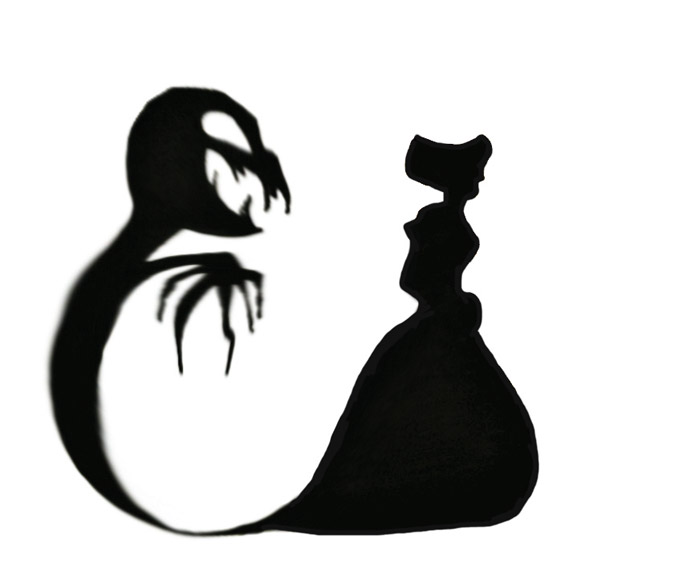Warning: Spoilers
The mansion in Guillermo Del Toro’s Crimson Peak is a character in itself. It breathes, bleeds, and moans. It’s rotting and sickly, yet simultaneously vibrant and beautiful; it’s also an accomplice to the brutal murders that have plagued its inhabitants for decades. With an ancient manor, a mysterious suitor, and an innocent, yet cunning heroine, it’s clear to see why Crimson Peak has been called a revival of the 19th century gothic. While gothic tropes abound in Crimson Peak it is also thematically similar to the quintessential gothic novel, Charlotte Brontë’s Jane Eyre.
Crimson Peak begins in 1895 in Buffalo, New York, when aspiring novelist Edith Cushing (Mia Wasikowska) meets the English aristocrat Thomas Sharpe (Tom Hiddleston). Sharpe is trying to get Edith’s father to invest in a clay-digging machine, and although he can’t gather the capital, he does win Edith’s heart. While her father disapproves of the match, he’s mysteriously murdered, leaving lonely Edith with no other choice but to marry Thomas.
Edith and Thomas move to his English manor, the collapsing Allerdale Hall. Soon after she arrives, skeletal, blood red spectres begin to haunt Edith, warning her of the dangers of the house. Colder than the ghosts themselves is Thomas’ aloof, but forceful sister Lucille, expertly played by Jessica Chastain.
Jane Eyre follows a strikingly similar plot. Jane is an orphan who is shipped off to a strict boarding school by a disdainful aunt. Upon graduating, Jane is hired by the eccentric Edward Rochester to be the governess for his ward. But whereas Thomas Sharpe is a master of the art of charm, Rochester is difficult to fall for. He’s objectively unattractive, and in a bizarre incident disguises himself as a fortune-telling gypsy woman in order to confront Jane. Yet after many late-night conversations, Jane and Rochester find themselves falling in love, and like Sharpe, Rochester inhabits an ancient and large manor that is hiding more than a few secrets within its rooms.
In both Crimson Peak and Jane Eyre, reality is more horrifying than the supernatural. For Jane, the discovery that Edward Rochester keeps his first wife chained in the attic after she has gone insane is far worse than the other-worldly projections of her active imagination. There is a logical explanation to the strange cries and sudden fires that happen at Thornfield Hall but the reality offers Jane little comfort. For Edith, ghosts are entirely real. She’s seen them since she was a child and upon moving to Allerdale Hall grotesque, malformed spectres visit her nightly. As disgusting as the ghosts may appear, they become Edith’s allies. Edith’s supernatural sight guides her in her investigation into the truth of Allerdale Hall and the Sharpe siblings. In Crimson Peak as in Jane Eyre, it’s not ghosts that haunt the manor—it’s the inhabitants.
The ancient manour homes oppress and trap each heroine in both Crimson Peak and Jane Eyre. Thornfield Hall and Allerdale Hall represent the lineage and traditions of the English aristocracy. In these homes, women must take on a traditional role and are expected to be subordinate to their husbands. Jane and Edith aren’t supposed to ask questions, and they’re certainly forbidden from looking into rooms that are off limits. Both Thornfield Hall and Alerdale Hall encapsulate Jane and Edith’s isolation, and the isolation of many women in the 19th century. These houses are all the young women have. They can’t go outside without permission and there are no other homes around for miles. When Jane and Edith try to escape, they are met with cold and snow. Both heroines face the ultimate choice: Do they leave their oppressive, dangerous home and risk dying in the cold, or stay and face the horror of their home and husband?
Guillermo Del Toro’s Crimson Peak sees the director returning to an aesthetic and thematic tradition pioneered in the 18th century. While Jane Eyre and Crimson Peak share themes and symbols, the two works diverge in stylistic choices. Crimson Peak is a major motion picture in 2015, abound with murder, violence, sex, and suspense. At almost 600 pages and a multitude of lengthy detailed descriptions, Jane Eyre can be a chore for the modern reader. With 168 years between the release dates of the two respective works, it’s no surprise that the conventions of popular entertainment have changed, yet the themes and messages of the two works successfully bridge the past and the present.










But SPOILERS
Jane Eyre has a happy ending.
Crimson Peak almost does. Thomas finds redemption and Edith really loved him. I kinda dig the bittersweet ones.